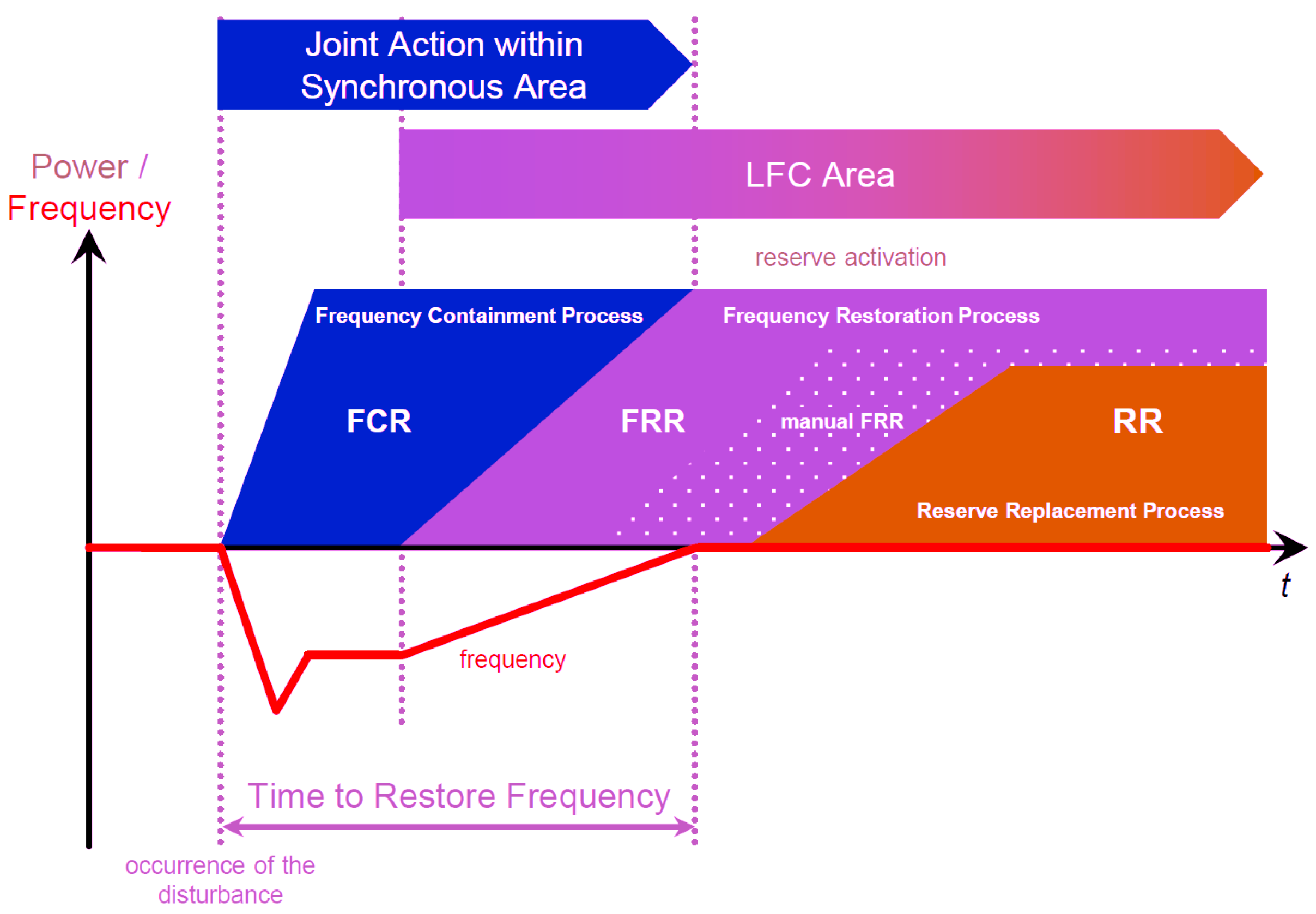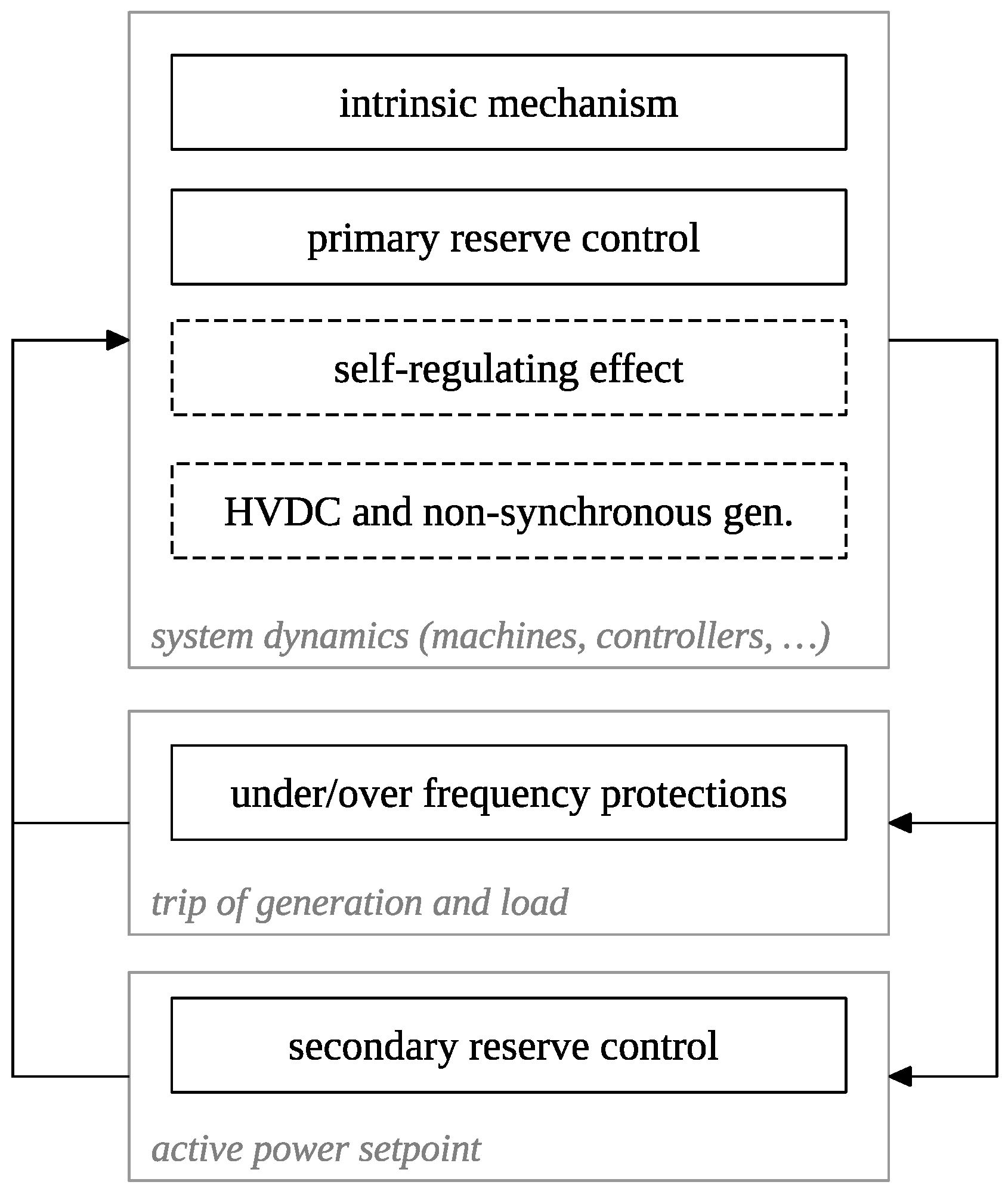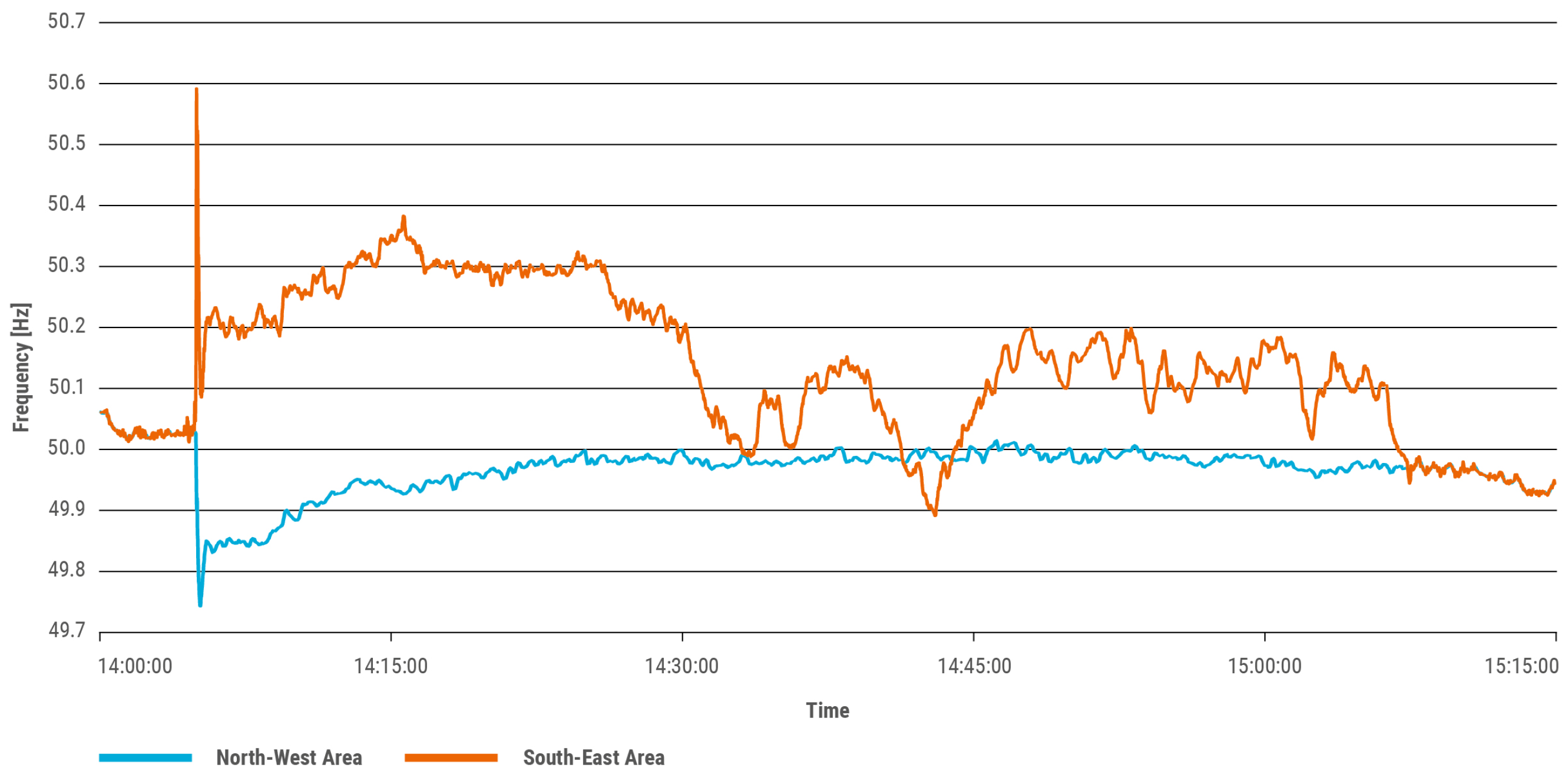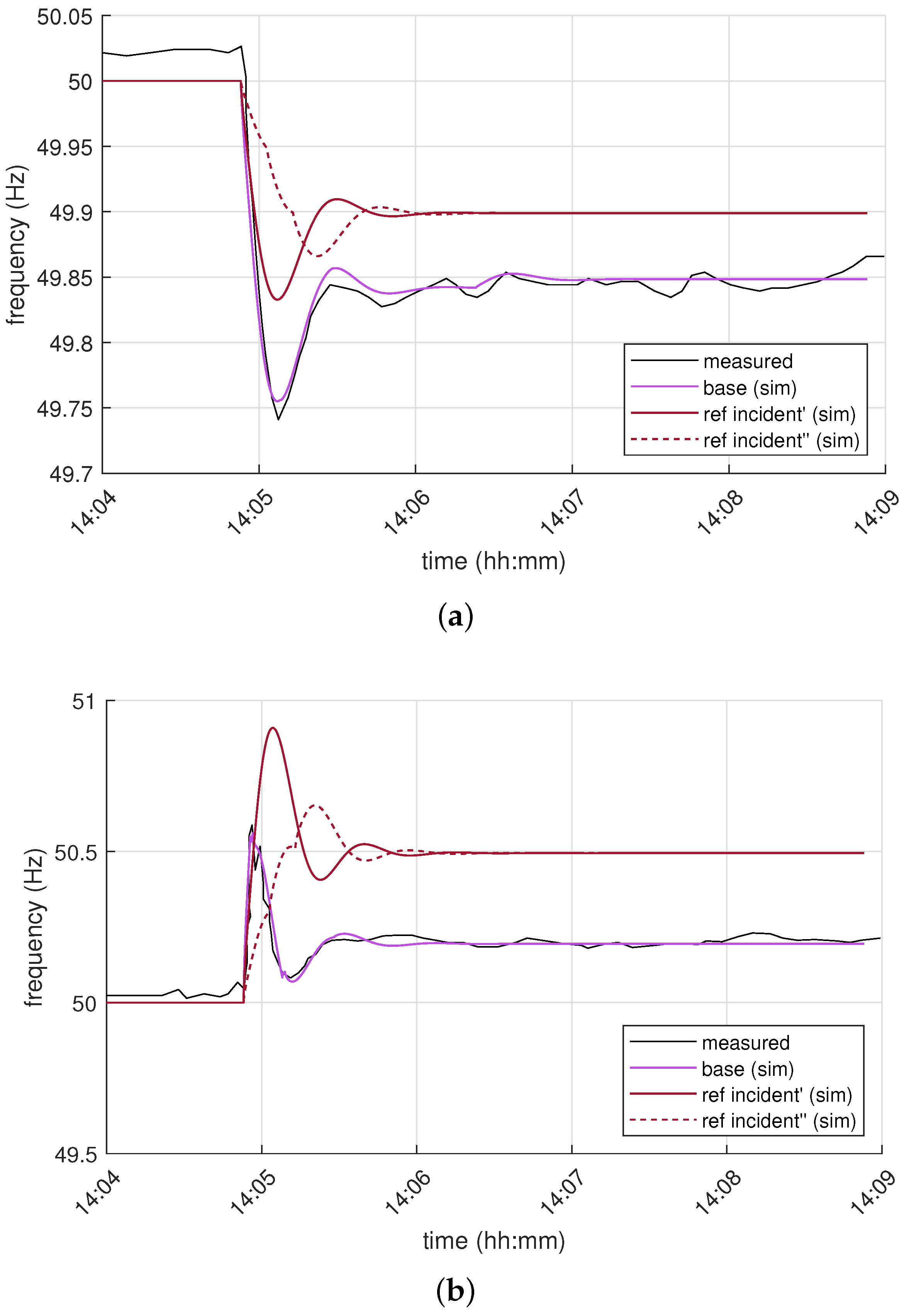1. Introduction
In recent years, the power system of the Continental Europe (CE) synchronous area has experienced major incidents leading to the separation of the system into two or more parts. Often, the system split resulted in a more severe disturbance in terms of power imbalance than the reference incident assumed by ENTSO-E as a design hypothesis for the dimensioning of primary control of the system. The expected increase in the share of renewable energy sources can potentially lead to a worsening of the situation: sources as solar and wind are typically interfaced to the grid through power electronics, so unless specific controls are applied, they make a limited contribution to the frequency control and they are more subject to disconnections, making the system less resilient and more vulnerable [
1,
2,
3,
4]. In addition, transmission capacities between parts of the power system have increased considerably. This leads to corresponding increases in the power exchanged between the different areas of the system, creating the actual risk of high power imbalances in case of system separation. The two aspects of increasing power exchanges and decreasing synchronous generation can, therefore, have a critical impact on the frequency stability of the system, especially in the case of potential system-split scenarios. The ENTSO-E also specifies that, in case of a system separation, much higher power imbalances may happen compared to the reference incident during interconnected operation [
1]. It is, therefore, strategic to assess the frequency stability of the system for situations of area separation, through specific investigations and analyses.
This work presents an analysis and simulation of the frequency containment reserve process in the power system of Continental Europe in conditions of system separation. An actual split event is considered in the investigations, and replicated according to a specific methodology. In the first part, the load-frequency control process and the related policy for frequency control in the CE synchronous area are briefly recalled and summarized. An up-to-date review and discussion regarding the frequency containment reserve is provided, including the description of concepts, policy and possible estimations of the power-frequency characteristic of the CE system. The modelling of the Continental Europe power system for the dynamic analysis of frequency transients is then introduced and described, discussing the use and required extensions of the model for the purposes of the investigations. The analysis of the frequency containment at the occurrence of a system separation is examined, taking an actual event into consideration, which happened in the CE system on the 8th January 2021. For the split event, specific simulation models for time-domain simulations of the two parts of the CE area are presented and implemented.
The main contribution of the work is the definition and the development of proper simulation models, able to reproduce the frequency transient that occurred in the parts of the CE system after the split event. The model adjustments and the specific simulation setup required to obtain a satisfactory match with the frequency measurements, and thus validate the models, are discussed. Through the analysis of the simulation results, the work also provides some relevant observations, indicating the decisive role of the temporal sequence of power imbalances and defensive disconnections, and the use of the power-frequency characteristic of the system in the representation of the frequency control process. The validated simulation models are finally used to extend the analysis to variant scenarios, investigating the occurred split incident under different assumptions such as limited defensive actions and low-inertia conditions. Moreover, another element of novelty consists in the analysis of the system-split condition itself. Indeed, many authors have investigated CE area stability, discussing the abilities of different generation technologies to provide a frequency containment reserve [
5,
6,
7] or the role of battery energy-storage systems [
8,
9,
10], however, the event of system split is barely studied. The rest of the paper is divided as follows:
Section 2 provides an overview of relevant aspects of the primary frequency control in the CE system, focusing in particular on the frequency-containment reserve process and the use and computation of the power-frequency characteristic;
Section 3 describes the specific details of dynamic modelling and simulation of the CE power system, discussing the required extensions and adaptations of the dynamic model made by the authors for the development of an accurate simulation of the separation event; analysis and simulations of the system split in the CE synchronous area are reported in
Section 4, pointing out the importance of a proper temporal distribution of power imbalances and defensive actions;
Section 4 reports the results of extended analyses done with the validated models, examining variant scenarios of missing defensive actions, reduced system inertia and comparison with the reference incident; finally, in
Section 5, the main results of the work are summarized with conclusive comments and remarks.
2. Frequency Containment Reserve
The load-frequency control structure defined by ENTSO-E is composed of different processes and stages at specific time ranges (
Figure 1). The Frequency Containment Reserve (FCR) process takes place in the very first seconds after the occurrence of the disturbance, and is responsible for the stabilization of the frequency after the disturbance at a steady-state value. The FCR involves the joint action of all the parts belonging to the synchronous area. The steady-state deviation reached at the end of the FCR process must be within the permissible limit values defined for the system. For the dimensioning of the FCR in the synchronous area of Continental Europe, an N-2 criterion was introduced in the late 1990s, following a deterministic methodology and considering a power imbalance of 3000 MW as a reference incident [
11,
12,
13].
During the FCR process, the intrinsic stabilization mechanism of the system takes place. For this stage, the ratio between the power imbalance that occurred in the system and the quasi-steady-state frequency deviation caused by that disturbance governs the behaviour of the system at the end of the primary frequency control. This ratio is known as the power-frequency characteristic or frequency bias factor and is defined by
where
is the power imbalance that occurred in the network and
is the frequency deviation observed at the steady-state. The value of
corresponds to the frequency deviation which is established at the end of the primary frequency control stage. The value of
is negative for power deficit (loss of generation) and positive for power surplus (loss of load). The setpoint value
for the overall power-frequency characteristic of the system is defined according to the specific policy described in [
15,
16], based on measurements, experience and theoretical considerations. The computation of
can be divided into the following terms [
17]
The aggregated equivalent droop
of the network can be computed by inverting the characteristic
and normalizing for nominal frequency
and power
For the given value of
= 150 GW used as a low load in the design hypothesis of the FCR [
1] and the minimum power-frequency characteristic of
= 15,000 MW/Hz, it results
= 20%. The 20% aggregated droop corresponds to the value reported in [
11,
12] for the CE system (formerly UCTPE/CENTREL network).
The latest version of the ENTSO-E (formerly UCTE) operation handbook on load-frequency control [
16] defines policy and numbers for the application of the previous equations. Equation (
2) defines the frequency containment reserve term of
, and it corresponds to the minimum frequency characteristic of 15,000 MW/Hz. This value is calculated according to the design hypothesis of 3000 MW loss of generation as a reference incident and of 200 mHz as the maximum permissible quasi-steady-state frequency deviation after the reference incident. The self-regulating effect of the total system load is taken into account with Equation (
3), and it is fixed by policy in the range 1–2%. In addition to the FCR and the self-regulation effect of the load, two additional components are included in the calculation. The first term is introduced based on the consideration that the power-frequency characteristic of the Continental Europe synchronous area is experienced to be, on average, 30% higher than the minimum required value. This term is calculated with Equation (
4) and it results in an average frequency characteristic
of 19,500 MW/Hz. The second term is related to the surplus-control of generation and it takes the self-control effects of generation into account. This term is calculated with Equation (
5) based on the mean generation power in the system, and it corresponds to an experienced linear frequency dependency of approximately 50% of all the generation units of the system reacting to frequency deviations.
The overall power-frequency characteristic setpoint for the Continental Europe synchronous area is then the sum of these four contributions, as per Equation (
6), and it finally results in 26,680 MW/Hz. This value corresponds to the specifications of 2009, the year of the latest available version of the operation handbook. The operational data specified in [
16] for the calculation of the setpoint
are reported in
Table 1. It is important to notice that the value of
is determined on the main assumption that the power-frequency characteristics of the synchronous area is constant over the specific time-span of one year. It has been observed, however, that the value of
is subject to variability depending on the time of day and on the composition of the generation units [
17], as it is reasonably expected.
The synchronous area of Continental Europe is normally divided into subareas or blocks, and each block is responsible for the coordination and contribution of the frequency regulation process. The requested contribution of a control block to the primary frequency control can be determined by the multiplication of the setpoint characteristic
of the entire synchronous area to the contribution coefficient
of the given control block
The contribution factors
are determined and published on a yearly basis for each control block, and, according to [
16], they can be calculated as the ratio between the energy generated in the given area
i and the total energy of the entire synchronous area. In a more recent document of ENTSO-E [
18], the contribution factors are determined as the sum of the electricity generation and consumption in the control area
i divided by the sum of the total electricity generation and consumption in the whole CE synchronous area. The contribution factors are, in any case, a reflection of the weight of the given area in the overall system. These factors are used to divide the total required power-frequency characteristic
among the control blocks. The factors
are also used to determine the share of each control block to the 3000 MW FCR, every year. The values of the coefficients
, computed according to latest load and generation data published by ENTSO-E [
19], are reported in
Table 2.
The contribution coefficients
are involved in the implementation of the joint action defined by ENTSO-E. In [
15,
16], the principle of joint action is stated as a fundamental measure to ensure the reliable and stable operation of the synchronous area, and it consists of a common reaction from each TSO of the synchronous area to a given disturbance in the system, according to the distribution of reserves for primary control determined by the coefficients
. The joint action is a fundamental phenomenon taking place during the FCR process (
Figure 1). For the principle of joint action to be realized, the power-frequency characteristic
of the single control blocks should be kept as constant as possible.
At the time of writing, there is no available revision of the load-frequency policy defined by ENTSO-E, and therefore no updated values of the power-frequency characteristic setpoint
for the synchronous area of Continental Europe. An assessment of a more updated value of
can be done in different ways. For instance, the frequency measurements corresponding to the forced outage of 1000 MW generation in Switzerland acquired by Swissgrid could be used for this purpose. The frequency measurements are reported here in
Figure 2. The event corresponds to a forced outage of generation performed by SwissGrid on September 2017.
It can be observed that the frequency after some seconds from the application of the disturbance drops to approximately 49.965 Hz, corresponding to a steady-state frequency deviation of 40–45 mHz, as the initial frequency is slightly higher than 50 Hz. From the knowledge of the frequency deviation produced by a given power imbalance, it is possible to calculate the power-frequency characteristic of the system at the observed conditions applying Equation (
1)
Another way is to repeat the calculations indicated in Equations (
2)–(
5) with the operational data of the Continental Europe that are currently available. From the statistical fact-sheet published by ENTSO-E for the year 2018 [
19], it is possible to determine a peak load of
= 450,600 MW, and a mean generation of
= 331,300 MW. Entering these values in Equations (
2)–(
5) and summing up the four contributions, it results in an overall power-frequency characteristic of approximately 27,300 MW/Hz.
The values and the considerations regarding the power-frequency characteristic of the CE power system, and the calculated contribution coefficients of the single countries belonging to the CE synchronous area will be used for the analysis and the simulation of the transient response of the CE system under separation, as described in the following sections.
3. Dynamic Model of Continental Europe
The dynamics of the CE interconnected power system have been studied in several works, using detailed [
21,
22,
23,
24,
25,
26,
27] and simplified models [
28,
29,
30]. Here, the dynamic model of Continental Europe originally provided by ENTSO-E is used to derive an equivalent model for the purposes of this investigation. This model is available at [
31] after the acceptance of ENTSO-E. The large-scale dynamic model includes 20,000 nodes, 1000 synchronous machines and 3000 controllers, and is a phasor representation of the Continental Europe synchronous area, suitable to reproduce the mean frequency transients (system inertia, frequency containment reserve) and the inter-area oscillations phenomena [
21]. The model does not consider the effects of local phenomena such as voltage transients, protection systems of lines, generators and other devices and special protection schemes and defense plans, specific control schemes such as Automatic Generation Control (AGC), emergency overfrequency and underfrequency controls, dynamic load behaviour and specific models of generation interfaced through power converters. According to the guidelines provided in [
32], a correct “local” configuration of the model must be done if specific studies have to be performed. The required modifications which are applied to the original model as part of this work are discussed later in
Section 4.
The representation of the basic system dynamics is realized using standard dynamic models for synchronous machines and for the corresponding controllers. The synchronous machines are represented with subtransient 6th-order round-rotor models. The controllers connected to the machine are automatic voltage regulators (AVR), power-system stabilizers (PSS) and turbine-governors. For these controllers, the standard models described in [
33] are used. The AVR and excitation system is modelled with the simplified excitation system SEXS, with deactivated PI controller. The standard model PSS2A is used as a power system stabiliser. The speed governor and turbine system is modelled with the steam turbine TGOV1. The block diagrams of the three controllers are shown in
Figure 3,
Figure 4 and
Figure 5, respectively.
The dynamic model of the CE synchronous area provided by ENTSO-E is used to develop an extended Load Frequency Control (LFC) model for the system, suitable for the purposes of the investigation of split events. The flowchart of the developed LFC model is shown in
Figure 6.
In the diagram, the blocks inside the box “system dynamics” represent the adaptation made by the authors of models and data originally provided by ENTSO-E in the dynamic model of the CE system. This block contains the intrinsic mechanism of the system reacting to a power imbalance and the primary frequency control actions which take place consequent to the disturbance. The block takes the transient behaviour of the synchronous machines connected to the system and the actions of the corresponding primary controllers into consideration for voltage and frequency regulation. The block “self-regulating effect” accounts for the self-regulating effect of the loads in the system. The block “HVDC and non-synchronous gen.” represents the possible support to the frequency regulation provided through HVDC interconnections and by non-synchronous generation sources operating in the frequency-sensitive mode. For the HVDC interconnections, the exchange can be operated within the different parts of the CE synchronous area, and also between the CE system and the other interconnected areas, such as the Nordic and the Great Britain systems. The two dashed blocks “self-regulating effect” and “HVDC and non-synchronous gen.” can be included in the simulation as part of the block “primary reserve control”, deriving aggregated equivalent parameters for droop and time constants. Regarding the dynamic contributions of the block “HVDC and non-synchronous gen.”, the approach of including it as equivalent is valid as long as the share of the non-synchronous sources is low compared to the overall power of the system. For higher share of power, a more accurate approach to the power converters simulation would be required.
The blocks containing the under/over-frequency protections and the secondary reserve control are additional blocks which are not present in the initial dynamic model of ENTSO-E. The first block implements the actions of specific under- and over-frequency protection schemes, in terms of disconnections of generation and load for the reduction in the frequency deviation. The second block is responsible for the activation of the secondary reserve control in the area, and it implements a simple integral control to adjust the active power setpoints sent to the governors of the generation units participating in the control.






















